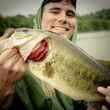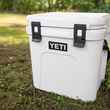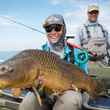The stocking report had to be wrong. A typo, a coding problem – something reasonable explained what I read.
Cottonwood Reservoir – MUSKIE TIGER
Donkey Lake – MUSKIE TIGER
Bullock Reservoir – MUSKIE TIGER
Why in the world would the Utah Division of Wildlife Resources (DWR) stock tiger muskie into those lakes?
Tiger muskie have long been popular here in Utah. My fishing buddy “Mysis” Mike has a photo album – a real one, with printed photos and everything – full of shots of him with tiger muskie. One shows him holding a 40-ish inch specimen next to a toddler-aged niece. The fish was as long as the niece was tall.
Mysis Mike caught that from Pineview Reservoir, a stocked fishery just off the busy Wasatch Front in northern Utah. Pineview is home to a hodgepodge of fish and plenty of weedy, tangled shallows. Perfect habitat for an ambush predator like a tiger muskie to hole up in.
For those of you still wondering, a tiger muskie is a cross between a northern pike and a muskellunge. They’re sterile, like most hybrid fish, and grow very large, very quickly. Since they’re such voracious predators, fisheries managers use them to help control bait and rough fish populations.
Take Gross Reservoir for example. It’s a 440-acre lake in Boulder County, Colorado, that was once known most for its outrageous population of white suckers.
“Ten years ago we had 78 percent sucker biomass in the reservoir,” said Colorado Parks and Wildlife Senior Aquatic Biologist Jeff Spohn, in an article for Colorado Outdoors. “We started stocking tiger muskies and brown trout and that has gone down to around 35 percent.”
Tiger muskies are easier to manage than brown trout, though, because they’re naturally sterile. Their inability to reproduce, coupled with their fully-piscivorous diet, makes them ideal tools for biologists to use when looking to reduce populations of invasive nongame fish.
Which is why the stocking report from the DWR confused me so much. None of the fisheries listed had problems with nongame fish populations. In fact, all three are solid trout lakes, and at least one has the potential to produce trophy-sized brookies.
Two of the lakes are in Utah’s Northeast Region, where my buddy Bryan Englebert is a fisheries biologist with the DWR. I called him up to get the skinny on what tiger muskie were doing in two of his lakes.
The muskies, Bryan told me, were serving the same purpose in those lakes that they do in most others. Controlling fish populations. Only in these lakes, the fish being controlled are brook trout.
~~~
The Idaho Department of Fish and Game was the first to try using tiger muskie to control brook trout populations. Bryan pushed to use them in Utah after hearing about their success in Idaho.
Much of that success is detailed in Volume 35, Issue 4 of the North American Journal of Fisheries Management. I’m sure everyone has a subscription to that scintillating magazine, right?
The first few lines of the abstract are telling in why Idaho fisheries biologists thought about using tiger muskie to help with brook trout populations:
“In western North America, nonnative Brook Trout Salvelinus fontinalis in alpine lakes threaten the persistence of native trout and often offer limited sport fishing opportunity as they are prone to stunting. Stocking tiger muskellunge . . . which are reproductively sterile, may be an option to eradicate Brook Trout in some alpine lakes.”
I reckon any angler here in the Rockies can rattle off a list of a dozen ponds full of stunted brookies at a moment’s notice. Alpine lakes full of small brookies are about as synonymous with alpine fishing in the West as permit are to the Florida Keys.
Brook trout are prolific reproductive fish and notoriously difficult to get rid of. Once they show up in a drainage, they attach themselves to the landscape better than almost any other trout. When you have so many fish competing for the small amount of food available in alpine settings, it’s no surprise that all fish stunt, and sport fishing suffers.
In an effort to reverse that trend, the biologists in Idaho picked 17 brook trout lakes to use as study samples for their new idea. 13 of the lakes were stocked with tiger muskie, while 4 were left alone as control groups.
For five years, the biologists sampled brook trout populations in all 17 lakes using gillnets. In lakes where tiger muskie were stocked, they’d catch 2.3 brook trout per net. Before the introduction of tiger muskie, the catch rate was 23.1 brook trout per net.
Interestingly enough, brook trout catch rates plummeted in the control lakes, too. But that’s indicative of the boom-and-bust nature of alpine fisheries.
What’s most intriguing, though, is that in lakes where tiger muskie were stocked, “the proportion of brook trout larger than 250mm in the catch increased significantly in years 1, 2, and 4 after stocking (compared with pre-stocking data) whereas no increase occurred in control lakes,” per the Idaho study.
250 mm is just under 10 inches long. Stocking tiger muskie in these alpine brook trout lakes obviously decreased the number of brook trout available, but significantly increased their size.
That outcome led to Utah trying the management method, and this year should be one where we start to see some major results. I have some hook-and-line (read: fly fishing) surveys planned with Bryan later this summer.
The outcome of the study from Idaho makes biological sense. Reduce the number of animals reliant on a food source, and you increase the size and health of the animals remaining. In this case, fewer brookies fighting each other for scuds, leeches, and chironomids meant bigger brook trout overall. The tiger muskie prey on the brook trout, keeping their prolific spawning in check. Since the tiger muskie are sterile, it’s relatively simple to keep a good number of larger brook trout alive.
And can you imagine the thrill of hooking a big tiger muskie in an alpine setting? In some cirque lake high in the Rockies?
That’s something I want to experience. This year, hopefully, I’ll get the chance.































Comments
Terry Donaldson replied on Permalink
Actually, I do have a subscription to the North American Journal of Fisheries Management!
Michael replied on Permalink
Good for them. I have been saying they should try this for 20 years.
Pages